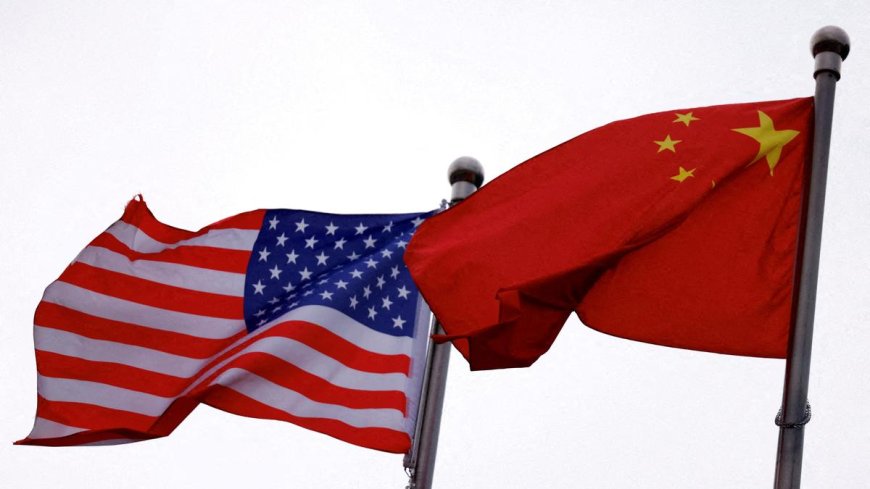U.S.-China trade agreement a mixed bag for India, say trade experts

U.S.-China trade agreement a mixed bag for India, say trade experts
Asarkari - Sarkari News, Jobs & Updates
By Priya Sharma
Navigating the Ripples: India's Economic Path Amidst U.S.-China Trade Dynamics
kam sabdo me kahein to, the complex U.S.-China trade agreement offers a mixed bag of potential benefits and significant hurdles for India's economic landscape, demanding strategic policy responses.
The ongoing trade discussions and agreements between the United States and China, two of the world's largest economies, invariably send ripples across the global economic stage. For India, a significant player in international trade and a rapidly growing economy, the implications of these agreements are multifaceted and warrant careful examination. Trade experts across the country are cautiously optimistic yet wary, suggesting that while new doors may open, fresh challenges are also likely to emerge. The true impact will depend on the specifics of any deal, global economic conditions, and India's own policy agility.
Potential Avenues for Growth: Seizing the Moment
One of the primary potential benefits for India arises from the concept of trade diversion. As the U.S. and China impose tariffs on each other's goods, India could potentially step in to fill the supply gaps created in both markets. This is particularly relevant for sectors where India has a competitive advantage.
Trade Diversion Opportunities
Experts point out that with U.S. tariffs making certain Chinese goods more expensive for American consumers, U.S. importers might look towards alternative sourcing destinations like India. Sectors such as textiles and apparel, chemicals, engineering goods, automotive components, and pharmaceuticals could see increased demand from the U.S. market. For instance, if U.S. buyers seek alternatives to Chinese-made home furnishings or light machinery, Indian manufacturers could find new export avenues, provided they meet the quality and price expectations. Similarly, China, looking to diversify its import sources away from the U.S., especially for agricultural products or certain raw materials, might turn to India.
Sector-Specific Gains
Beyond general trade diversion, specific commitments within any U.S.-China agreement could indirectly benefit India. If, for example, China commits to larger purchases of certain agricultural goods globally as part of a deal, and if U.S. supply is prioritized, other markets previously supplied by the U.S. might open up for Indian agricultural exporters. However, this is a delicate balance, as it could also mean increased competition from U.S. products in other markets.
Navigating the Hurdles: Challenges on the Horizon
Despite the potential upsides, the U.S.-China trade dynamics also present significant challenges for the Indian economy. The nature of these agreements can be unpredictable, and their enforcement often leads to further market uncertainties.
Increased Competition and Dumping Risks
A major concern is the possibility of China diverting its unsold inventory (due to U.S. tariffs) to other markets, including India, at highly competitive or even predatory prices. This "dumping" of goods, especially in sectors like steel, electronics, and chemicals, could severely undermine Indian domestic manufacturers, impacting local production and employment. Furthermore, India isn't the only country eyeing the trade diversion opportunities. Nations in Southeast Asia, like Vietnam and Bangladesh, are also strong contenders, meaning India faces stiff competition to capture any new market share. This necessitates a rapid improvement in India's manufacturing competitiveness and export infrastructure.
Impact on Global Supply Chains and Investment
The U.S.-China trade tensions have already caused disruptions in global supply chains. While some companies might consider relocating manufacturing bases out of China (the "China Plus One" strategy), India needs to actively create a more favorable investment climate to attract such relocations. Issues related to ease of doing business, land acquisition, labor laws, and logistical efficiency need consistent attention. Without proactive measures, India might lose out on potential foreign direct investment (FDI) redirected from China.
The Unpredictability Factor
The very nature of these trade agreements can be volatile. Deals can be partial, subject to revisions, or face implementation challenges, leading to prolonged uncertainty in global trade. This makes long-term planning difficult for Indian businesses and exporters. Moreover, if a U.S.-China deal leads to a significant increase in bilateral trade between them, it could potentially reduce the overall global trade pie available for other countries, including India.
Expert Opinions and Government's Strategic Imperatives
Trade bodies like the Federation of Indian Export Organisations (FIEO) have often highlighted both the opportunities in sectors like chemicals and engineering goods and the threats from potential dumping. Economists suggest that India needs a multi-pronged strategy. This includes aggressively pursuing Free Trade Agreements (FTAs) with key markets, enhancing domestic manufacturing capabilities through schemes like 'Make in India' and Production Linked Incentive (PLI) schemes, and improving export-related infrastructure, such as ports and logistics networks.
The Indian government has been watchful, often reiterating its commitment to protecting domestic industry while seeking fair market access abroad. Diplomatic engagement and careful negotiation in multilateral forums also play a crucial role in safeguarding India's interests.
Asarkari's Commentary: Navigating the New Trade Landscape
At Asarkari, our research indicates that the U.S.-China trade situation is more than just a bilateral issue; it's a catalyst for a broader recalibration of global trade. For India, this isn't merely about passively waiting for opportunities to arise from trade diversion. It's a call to proactive economic statecraft. India must enhance its product quality, scale, and compliance with international standards to truly capitalize on any shifts. For example, in the electronics sector, while there's potential, India needs to build a more robust component ecosystem to reduce reliance on imports and become a genuine alternative to China for assembly and manufacturing.
Our analysis also shows that past trade disputes, such as those involving steel or solar panels, have had tangible impacts on Indian domestic producers, sometimes positive (if protective measures are effective) and sometimes negative (if retaliatory tariffs hit Indian exports). The current scenario is far more complex due to the sheer scale of U.S.-China trade. India must also look inward, strengthening its domestic market to absorb shocks and investing in research and development to move up the value chain. Relying solely on others' disputes for economic gain is a short-term view; building intrinsic economic strength is the long-term solution. The focus should be on creating a resilient and competitive Indian economy that can thrive regardless of the trade winds blowing between Washington and Beijing. This includes skilling the workforce for advanced manufacturing and digital trade, which are becoming increasingly important. For more updates on economic policies and international trade news, visit https://asarkari.com.
Conclusion: A Call for Strategic Adaptation and Resilience
In conclusion, the U.S.-China trade agreement, in its various forms and stages, presents a quintessential "mixed bag" for India. There are undeniable opportunities for Indian exporters to gain market access in both the U.S. and China, particularly in specific sectors. However, these are counterbalanced by significant risks, including intensified competition, the threat of dumped goods, and broader global economic uncertainties. India's ability to successfully navigate this complex environment will depend on its strategic foresight, policy agility, and the collective efforts of its government and businesses to enhance competitiveness and build economic resilience. The path forward requires not just cautious optimism but also robust preparation and decisive action.
By Priya Sharma, Team Asarkari
Keywords
U.S.-China trade agreement impact on India, India trade opportunities US China deal, challenges for Indian economy from US China trade, India export sector analysis, global trade shifts India, US China tariff war effects India, Indian industries US China trade, Asarkari sarkari news, economic policy India, trade diversion India, India manufacturing competitivenessWhat's Your Reaction?
 Like
0
Like
0
 Dislike
0
Dislike
0
 Love
0
Love
0
 Funny
0
Funny
0
 Angry
0
Angry
0
 Sad
0
Sad
0
 Wow
0
Wow
0










































